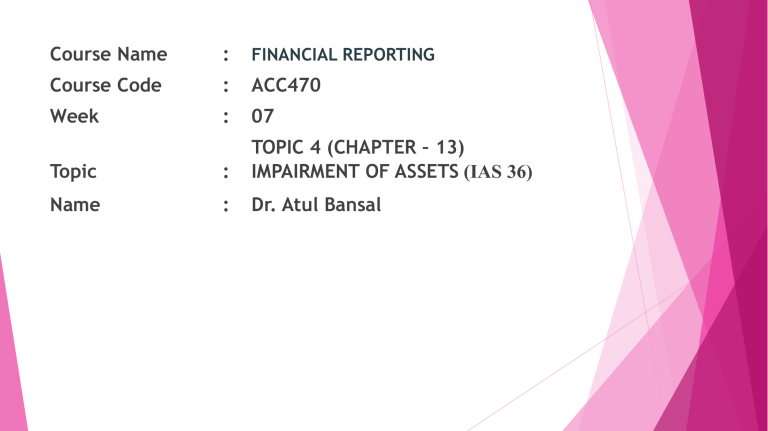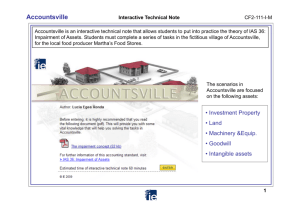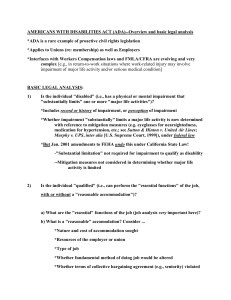
Course Name : FINANCIAL REPORTING Course Code : ACC470 Week : 07 Topic : TOPIC 4 (CHAPTER – 13) IMPAIRMENT OF ASSETS (IAS 36) Name : Dr. Atul Bansal IMPAIRMENT OF ASSETS (IAS 36) Impairment is the estimated loss of value of an asset. There are certain circumstances that reduce the value of an asset that a company has purchased until it is eventually depreciates fully. The impairment reflects how in accounting it is often difficult to recover the full value of the asset. Impairment of assets can be explained as a sudden or unexpected decline in an asset’s service utility, like factory, vehicle, or property. This might result from physical damage to the asset, changes to the legal code, or uselessness resulting from technological innovation. What is impairment of assets? Impairment of assets refers to the concept in accounting when the book or carrying value of an asset exceeds its ‘recoverable amount’. IAS 36 defines the recoverable amount of an asset as the higher of its fair value less cost to sell (or net realizable value) and its value in use. Objective of IAS 36 To ensure that assets are carried at no more than their recoverable amount, and to define how recoverable amount is determined. Objective Assets should not be carried at amounts in excess of their recoverable amount. IAS 36 defines recoverable amount as the higher of value in use and net selling price. Asset is “impaired” if carrying amount exceeds recoverable amount. 4 Impairment Applies to : 1. Property – Plant - & Equipment's 2. Goodwill and Intangible Assets 3. Investments in subsidiaries, associates and Joint ventures Scope or Impairment does not Applies to : inventories; deferred tax assets; assets arising from construction contracts; assets arising from employee benefits; financial assets included in scope of IAS 32 ( IAS 36 applies to investments in subsidiaries, associates and joint ventures). DEFINITIONS OF TERMS: IMPAIRMENT OF ASSETS Recoverable amount of an asset or a cash-generating unit. The higher of its fair value less costs to sell and its value in use. Value in use. The discounted present value of the future cash flows expected to arise from an asset or a cash-generating unit. Carrying amount: the amount at which an asset is recognized in the balance sheet after deducting accumulated depreciation and accumulated impairment losses Recoverable amount: the higher of an asset's fair value less costs of disposal* (sometimes called net selling price) and its value in use * Prior to consequential amendments made by IFRS 13 Fair Value Measurement, this was referred to as 'fair value less costs to sell'. DEFINITIONS OF TERMS: IMPAIRMENT OF ASSETS Cash-generating unit. The smallest group of assets that can be identified that generates cash flows independently of the cash flows from other assets. Fair value less costs to sell. The amount obtainable from the sale of an asset or cash generating unit in an arm’s-length transaction between knowledgeable, willing parties, less the costs of disposal. Impairment loss. The amount by which the carrying amount of an asset or cash-generating unit exceeds its recoverable amount. Value in use: the present value of the future cash flows expected to be derived from an asset or cash-generating unit Identifying Impaired Assets Assess at each reporting date whether any indication that asset may be impaired. - IAS 36 includes list of internal and external factors that must, at a minimum, be considered and whose existence provides evidence that asset may be impaired. Only need to test for impairment (i.e., measure recoverable amount) if there is indication that asset may be impaired. 8 Measuring Recoverable Amount Higher Price of Value in Use and Net Selling Net Selling Price Amount obtainable from sale in arm’s length transaction between knowledgeable, willing parties, less costs of disposal. Value in Use Present value of estimated future cash flows expected to arise from continued use and disposal at end of useful life. 9 Value in Use Considerations 1. The basis for the entity’s estimates of future cash flows – that is, what estimates to make about how much those cash flows should be; this is inherently very judgmental; 2. The composition of estimates of future cash flows – that is, which cash flows should be included; detailed guidance is provided on this; and 3. The discount rate that should be used; detailed guidance is provided on this, but again it is a very judgmental area. 10 Measuring Recoverable Amount Value in Use – Future Cash Flow Estimates Should be based on: management’s best estimate of economic conditions that will exist over asset’s remaining useful life; and most recent financial budgets/forecasts approved by management and covering maximum period of 5 years (unless longer period can be justified). Cash flows beyond 5 years to be estimated by extrapolating budgets/forecasts using steady or declining growth rate (unless increasing rate can be justified). 11 Continued-Measuring Recoverable... Value in Use – Future Cash Flow Estimates (cont.) Must be estimated for asset in its current condition and should included expected: cash inflows from continuing use; cash outflows necessarily incurred to generate cash inflows and either directly attributable to asset or that can be allocated on reasonable and consistent basis; and net cash flows on disposal at end of useful life in arm’s length transaction after deducting disposal costs. 12 Continued-Measuring Recoverable... Value in Use – Future Cash Flow Estimates (cont.) Should not include future cash flows expected to arise from: future restructuring to which enterprise is not yet committed; future capital expenditure to enhance asset in excess of originally assessed standard of performance; or financing activities or income tax receipts/payments. 13 Future Cash flow Considerations Use one of the following two methods: Forecast cash flows in real terms – do not increase to reflect future inflation—Discount at a real discount rate Include estimated inflation –Discount at a nominal rate of interest (one including inflation) To avoid double counting, only include cash inflows and outflows from the asset or CGU under consideration in the forecasts and calculations Exclude cash inflows relating to the following: a future restructuring to which an enterprise is not yet committed; or future capital expenditures that will improve or enhance the asset in excess of its originally assessed standard of performance. 14 Measuring Recoverable Amount Value in Use – Discount Rate Pre-tax rate that reflects current market assessments of time value of money and risks specific to the asset. Should not reflect risks for which future cash flow estimates have been adjusted. As a starting point, can take into account WACC, incremental borrowings rate and other market borrowing rates. These rates are then, adjusted to reflect market assessment of specific risks associated with projected cash flows and to exclude not relevant to projected cash flows. Next Class on Thursday 15 Impairment Losses Impairment loss = any excess of carrying amount over recoverable amount. Reduce carrying amount of asset to recoverable amount and recognize impairment loss as an expense, unless asset carried at revalued amount (in which case treat as revaluation decrement). 16 Recording Impairment Losses If asset is maintained at historical amortized cost (the “benchmark” treatment) Recognize as current period expense in income from operations as either: Part A of depreciation; or separately identified charge 17 Continued-Recording…. If asset is maintained under revaluation (the allowed alternative treatment) Impairment adjustment will be accounted for as revaluation decrease of a previous upward revaluation in stockholder’s equity Charge impairment loss against revaluation surplus If the entire revaluation account is eliminated due to recognition of impairment, charge any excess impairment to expense The revaluation account cannot contain a net debit balance. 18 Cash Generating Units Recoverable amount should be estimated for individual asset where possible. But, recoverable amount of individual asset not determinable if: asset’s value in use is likely to differ from its net selling price (e.g., specialized item of plant); and asset does not generate cash inflows from continuing use that are largely independent of those from other assets. In such cases, recoverable amount must be determined for cash generating unit asset belongs to. 19 Continued-Cash Generating Units CGU = smallest identifiable group of assets generating cash inflows from continuing use that are largely independent of cash inflows from other assets/groups of assets. Only include assets that can be allocated to CGU directly or on reasonable and consistent basis. Must be identified consistently from period to period (unless a change is justified). 20 Identification of cash-generating unit– Practical applications See separate handout for detailed discussion on identification of: Multi locations Restaurant chains Retailers Bank branches Hotels Petrol stations Vertically integrated operations 21 Next Class Cash Generating Units Even if part/all of the output produced by an asset/group of assets is used by other units within the enterprise, treat as separate CGU if active market exists for that output. Use best estimate of future market prices for output to determine value in use. CGU recoverable amount = higher of CGU’s value in use and net selling price. Test CGU for impairment by comparing CGU carrying amount to CGU recoverable amount. 22 Continued-Cash Generating Units Goodwill and “Corporate” Assets Do not generate independent cash flows and can support one or more CGU. Need to assess whether they can be allocated to CGUs they support on reasonable and consistent basis. Therefore, when testing CGU for impairment, include in CGU’s carrying amount any part of goodwill and corporate assets that can be allocated to that CGU on reasonable and consistent basis. 23 Continued-Cash Generating Units Goodwill and “Corporate” Assets (cont.) For goodwill and corporate assets that cannot be allocated to CGUs they support on reasonable and consistent basis: identify smallest CGU to which carrying amount of goodwill and corporate assets can be allocated on reasonable and consistent basis (the “larger” CGU); then, test “larger” CGU for impairment by comparing “larger” CGU carrying amount to “larger” CGU recoverable amount. 24 Continued-Cash Generating Units Allocating CGU Impairment Individual Assets in CGU Allocate in the following order: first, Loss to to any goodwill allocated to the CGU; then, to other assets in the CGU on pro-rata basis based on carrying amount of each asset. When allocating, must not reduce carrying amount of asset below higher of: net selling price (if determinable); value zero. in use (if determinable); 25 Reversal of Impairment Loss Assess at each reporting date whether any indication that all/part of impairment loss recognized in previous period has reversed. IAS 36 includes list of internal and external factors that must, at a minimum, be considered and whose existence provides evidence that impairment loss may have reversed. Only need to test for reversal of impairment if there is indication that impairment loss may have reversed. 26 Continued-Reversal of Impairment Loss Can only reverse impairment loss if estimates used to determine recoverable amount have changed since last impairment loss recognized. E.g., change in amount/timing of estimated future cash flows or discount rate if recoverable amount based on value in use. 27 Continued-Reversal of Impairment Loss Reversing Impairment Loss for Individual Asset Increase carrying amount to recoverable amount (but cannot exceed carrying amount asset would have had if impairment loss had not previously been recognized). Recognize reversal of impairment loss as revenue, unless asset carried at revalued amount (in which case treat as revaluation increment). 28 Reversals of Previously Recognized Impairments on Revaluation Assets Report the recovery as a reversal of the impairment If the previous impairment was accounted for entirely as reversal upward revaluations, account for as an upward revaluation and increase to an equity account, not reported through earnings. If impairment had eliminated the entire revaluation capital account, and the excess loss was reported in earnings, account for later recovery in earnings to the extent the earlier write-down had been so reported, with the balance taken to the 29 stockholders’ equity. Impairments Mitigated by Recoveries or Third Party Compensation Typically related to natural or physical damages to long-lived assets Example: Commercial insurance payment for flood damaged equipment Impairment must be recognized and cannot be offset by actual or estimated recovery Account separately reimbursement claim Third party compensation should be recognized as income when funds become receivable for impairment and 30 Disclosure Disclosure by class of assets: [IAS 36.126] • • impairment losses recognized in profit or loss impairment losses reversed in profit or loss • which line item(s) of the statement of comprehensive income • impairment losses on revalued assets recognized in other comprehensive income • impairment losses on revalued assets reversed in other comprehensive income Disclosure Disclosure by reportable segment: [IAS 36.129] • impairment losses recognized • impairment losses reversed Other disclosures: If an individual impairment loss (reversal) is material disclose: [IAS 36.130] • events and circumstances resulting in the impairment loss • amount of the loss or reversal • individual asset: nature and segment to which it relates • cash generating unit: description, amount of impairment loss (reversal) by class of assets and segment THANK YOU



